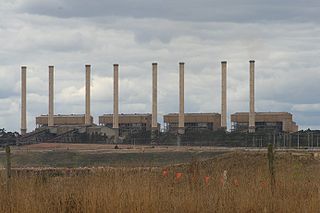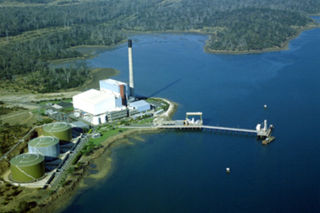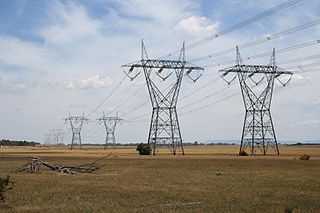Related Research Articles

The Loy Yang Power Station is a brown coal- fired thermal power station located on the outskirts of the city of Traralgon, in south-eastern Victoria, Australia. It consists of two sections, known as Loy Yang A and Loy Yang B. Both Loy Yang A and B are supplied by the Loy Yang brown coal mine. The Loy Yang power stations are located in the brown coal rich Latrobe Valley, along with the Yallourn Power Station.
Snowy Hydro Limited is an electricity generation and retailing company in Australia that owns, manages, and maintains the Snowy Mountains Hydro-electric Scheme that consists of nine hydro-electric power stations and sixteen large dams connected by 145 kilometres (90 mi) of tunnels and 80 kilometres (50 mi) of aqueducts located mainly in the Kosciuszko National Park. Snowy Hydro also owns and operates two gas-fired power stations in Victoria and one in New South Wales, three diesel power stations in South Australia and owns two electricity retailing businesses, Red Energy and Lumo Energy.

The Hazelwood Power Station was a decommissioned brown coal-fuelled thermal power station located in the Latrobe Valley of Victoria, Australia. Built between 1964 and 1971, the 1,600-megawatt-capacity power station was made up of eight 200MW units, and supplied up to 25% of Victoria's base load electricity and more than 5% of Australia's total electricity demand. It was a 'subcritical' pulverized coal-fired boiler. The station was listed as the least carbon efficient power station in the OECD in a 2005 report by WWF Australia, making it one of the most polluting power stations in the world. At 1.56 tonnes of CO2 for each megawatt hour of electricity, it was 50% more polluting than the average black coal power station in New South Wales or Queensland. Hazelwood emitted 14% of Victoria's annual greenhouse gas emissions and 3% of Australia's greenhouse gas emissions.
EnergyAustralia is an electricity generation, electricity and gas retailing private company in Australia. It is one of the "big three" retailers in the National Electricity Market. It generates electricity primarily using coal fired generation, at the Yallourn Power Station in Victoria, and the Mount Piper Power Station in New South Wales. 10% of its generation is from wind power, 32% from gas, and 58% from coal. It is Australia's second biggest emitter of greenhouse gases, after AGL Energy. As a loss making company in 2023, its parent in Hong Kong, CLP Group, has stated that it is looking for partners for renewable energy investment, however as of this time, there were no plans to build new renewable energy itself.

The State Electricity Commission of Victoria is a government-owned electricity company in Victoria, Australia. Originally established to generate electricity from the state's reserves of brown coal, the SEC gradually monopolised most aspects of the Victorian electricity industry, before being broken up and largely privatised in the 1990s. After several decades of dormancy, it was revived in 2023 to invest in renewable energy and storage markets.
Alinta Limited was an Australian energy infrastructure company. It has grown from a small, Western Australia-based gas distributor and retailer to the largest energy infrastructure company in Australia. It was bought in 2007 by a consortium including Singapore Power and various parties which include the now defunct Babcock & Brown funds.
Babcock & Brown LP was a global investment and advisory firm, established in 1977, based in Sydney, Australia, that went into liquidation in 2009.
Powerco is the largest dual-energy distribution company in New Zealand by length, and is one of only two dual-energy distributors in the country.

Ballylumford power station "C" station is a natural-gas-fired power station in County Antrim, Northern Ireland, UK. With its main plant generating almost 700 megawatts of electricity, it is Northern Ireland's largest power station and provides half its power. Overall the station can produce 693 MW. The plant is located at the tip of the Islandmagee peninsula, which separates Larne Lough from the Irish Sea. The lough is a Site of Special Scientific Interest. The 3 chimneys of the now decommissioned "B" station are 126 metres tall. East of the station is the Ballycronan More converter station, the Northern Ireland end of the Moyle Interconnector, a subsea HVDC interconnector connecting the NI electricity system to Great Britain.
Redbank Power Station is a biomass power station located in Warkworth, in the Hunter Valley of New South Wales, Australia. The station is currently awaiting a restart of operations after converting from its original use as a coal-fired power station. Redbank is unique for its utilisation of circulating fluidised bed technology, the only generator of its kind in Australia. Upon re-fire, the station will operate using 100% biomass at a capacity of 151MW of electricity.

The Bell Bay Power Station was a power station located in Bell Bay, on the Tamar River, Tasmania, Australia, adjacent to the Tamar Valley Power Station, with which it was often confused. It was commissioned between 1971 and 1974 as an oil fired thermal power station, and was converted to natural gas in 2003, after the commissioning of the Tasmanian Gas Pipeline, a submarine gas pipeline which transports natural gas from Longford, Victoria, under Bass Strait, to Bell Bay, Tasmania. As the power station's primary role was to provide system security in the event of drought for Tasmania's predominantly hydro-electric based generation system it only was rarely called on to operate, resulting in intervals of five to eight years between periods of significant use. After the commissioning of Basslink in 2006, the power station was decommissioned in 2009.

Drax Group plc, trading as Drax, is a power generation business. The principal downstream enterprises are based in the UK and include Drax Power Limited, which runs the biomass fuelled Drax power station, near Selby in North Yorkshire. The Group also runs an international biomass supply chain business. The company is listed on the London Stock Exchange and is a constituent of the FTSE 250 Index.

AGL Energy Ltd is an Australian listed public company involved in both the generation and retailing of electricity and gas for residential and commercial use. AGL is Australia's largest electricity generator, and the nation's largest carbon emitter. In 2022, 83% of its energy came from burning coal.

The energy policy of Australia is subject to the regulatory and fiscal influence of all three levels of government in Australia, although only the State and Federal levels determine policy for primary industries such as coal. Federal policies for energy in Australia continue to support the coal mining and natural gas industries through subsidies for fossil fuel use and production. Australia is the 10th most coal-dependent country in the world. Coal and natural gas, along with oil-based products, are currently the primary sources of Australian energy usage and the coal industry produces over 30% of Australia's total greenhouse gas emissions. In 2018 Australia was the 8th highest emitter of greenhouse gases per capita in the world.

The Newport Power Station was a complex of power stations located on the west bank of the Yarra River, approximately 6 km south-west of Melbourne, Victoria, Australia, in the suburb of Newport. Newport A, B, and C were coal-fired plants which operated at the site between 1919 and the 1980s, and were claimed to be the largest power station in the southern hemisphere in 1953 with 42 boilers and 14 turbo-alternators producing 327 megawatts (439,000 hp).

Energy in Victoria, Australia is generated using a number of fuels or technologies, including coal, natural gas and renewable energy sources. Brown coal, historically, was the main primary energy source for the generation of electricity in the state, accounting for about 85% of electricity generation in 2008. The amount of coal-fired power has decreased significantly with the closure in 2017 of the Hazelwood power station which supplied around 20% of Victoria's electricity, and to a lesser extent with the exit of Anglesea power station in 2015. Brown coal is one of the largest contributors to Australia's total domestic greenhouse gas emissions and a source of controversy for the country. Australia is one of the highest polluters of greenhouse gas per capita in the world.

AusNet Services is an Australian energy delivery services business, owning and operating more than $11 billion of electricity and gas network assets. It is privately held, and was formerly listed on the Australian Securities Exchange (ASX) and the Singapore Exchange (SGX). AusNet is currently owned by Australian Energy Holdings No 4 Pty Limited, a company controlled by Brookfield Asset Management. The co-investors include pension funds in Australia and Canada.

The Uranquinty Power Station is a 640-megawatt (860,000 hp) natural gas-fired power station located in Uranquinty, New South Wales, Australia, comprising four Siemens V94.2 gas turbines. It is the second largest gas-fired power station in New South Wales, and is used during peak loads.

SGSP (Australia) Assets Pty Ltd (SGSPAA), trading as Jemena, is an Australian company that owns, manages or operates energy infrastructure assets in the eastern states of Australia including Queensland and New South Wales, and gas pipelines and gas and electricity distribution networks in Victoria and the Northern Territory. It is 60% owned by State Grid Corporation of China and 40% by Singapore Power.
Tamar Valley Power Station is a $230 million natural gas-fired power station located in Bell Bay in the Tamar Valley, Tasmania. It is owned by Hydro Tasmania, and is immediately adjacent to the decommissioned Bell Bay Power Station, which is also owned by Hydro Tasmania.
References
old Ecogen Energy so t
- ↑ "News Release, Office of the Treasurer: Ecogen Energy sold". robertclark.net. 28 March 1999. Archived from the original on 5 June 2008. Retrieved 7 March 2010.
- ↑ Rod Myer (13 November 2006). "Big expansion planned for Newport". The Age. theage.com.au. Retrieved 7 March 2010.
- ↑ "Babcock & Brown Power sells Ecogen to pay debt". The Australian. theaustralian.com.au. 18 July 2008. Retrieved 7 March 2010.
- ↑ Macdonald-Smith, Angela (28 July 2017). "IFM Investors to sell Victorian gas-fired power stations". Australian Financial Review .